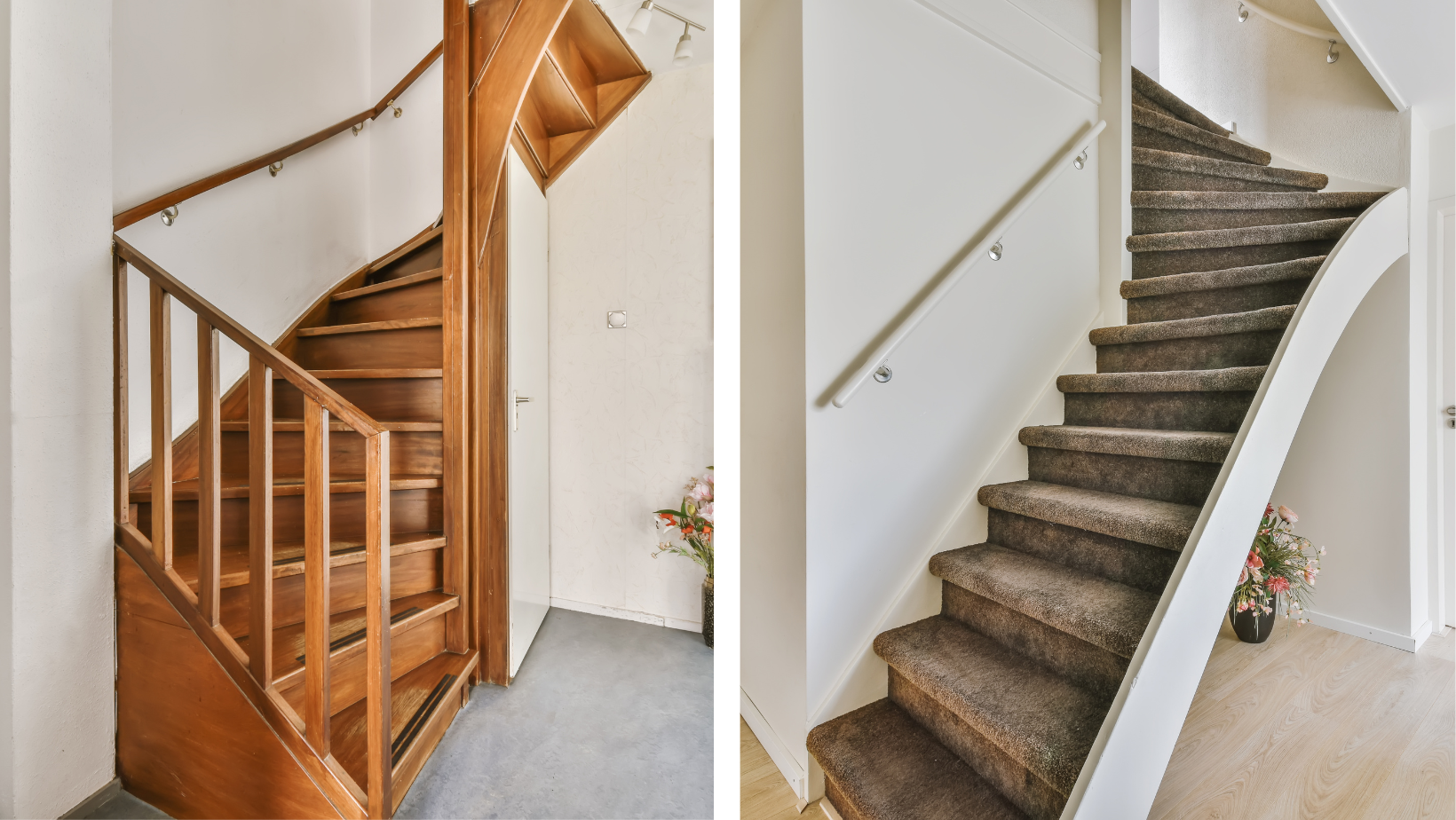Wood stairs bring charm to any home—but without the right protection, they can quickly show signs of wear.
The best way to protect wood stairs is by using carpet stair treads, applying durable wood finishes, and minimizing exposure to moisture and heavy foot traffic.
These simple solutions help prevent scratches, dents, and fading—keeping your stairs safe and beautiful.
In this guide, you'll learn how to protect wood stairs using affordable, DIY-friendly options that don’t sacrifice style.
From picking the right materials to understanding simple maintenance, we’ll walk you through everything you need to know.
Whether you have pets, kids, or just want a longer-lasting staircase, this article gives you practical tools to get it done right.
Why Wood Stairs Need Protection
Every day, your stairs deal with constant traffic.
Shoes with grit and gravel wear down the finish. Pets leave behind hair, scratches, and muddy pawprints.
Sunlight can fade the color of the wood, and humidity can cause expansion and cracking over time.
All of this means one thing: if you don’t protect your wood stairs, they’ll start to look worn out—fast.
Preserving their beauty isn’t just about aesthetics.
It’s about keeping your family safe, preventing costly repairs, and maintaining the value of your home.
Daily Damage: What You're Up Against
Let’s break it down:
-
Scratches and dents from shoes, toys, and pet claws
-
Moisture damage from spills, wet shoes, or high humidity
-
UV fading from exposure to direct sunlight
-
Slippery surfaces that increase the risk of falls
-
Dust and dirt buildup that wears down the finish
Even the cleanest households can’t avoid wear entirely.
That’s why using protective solutions is one of the smartest ways to care for your home.
Carpet Stair Treads: A Simple, Stylish Shield
Carpet stair treads offer one of the easiest, most effective ways to protect wood stairs—especially for busy households.
These are individual pieces of carpet designed to fit each step.
They’re easy to install, come in a range of colors and materials, and most importantly, they help absorb the impact from daily foot traffic.
With stair treads, you get:
-
A soft, non-slip surface that reduces falls
-
Less noise when going up and down
-
Protection from scratches, dents, and dirt
-
A quick, DIY installation—no need for nails or tools
The best part?
When it’s time for a refresh, you can remove or replace the treads without damaging the wood underneath.
Wood Finishes: Sealing In Strength
Wood finishes are another reliable way to protect your stairs—especially if you want to keep the wood grain visible.
Finishes like polyurethane, lacquer, and varnish form a tough, clear coating that seals out moisture and reduces scratching.
They also help preserve the rich tone and texture of your wood.
To apply a wood finish:
-
Clean and sand the surface to remove old coatings or imperfections.
-
Choose your preferred finish—water-based for quicker drying, oil-based for deeper color.
-
Apply in thin layers, allowing each coat to dry fully.
-
Finish with light sanding and a final coat for maximum durability.
While this option takes more time than treads, it’s a long-lasting way to boost protection and shine.
Wood Stains: Beauty with Benefits
If you want to add color and protect your stairs at the same time, wood stains are the way to go.
Stains seep into the surface of the wood, adding richness and tone while also providing a basic level of defense.
You can pair stains with finishes to create a layered approach—color plus protection.
Choose from:
-
Light stains for a bright, natural look
-
Medium tones for warmth and character
-
Dark stains for drama and bold style
After staining, be sure to apply a protective finish over the top to lock it in and guard against spills or scratches.
The Problem With Traditional Carpet Runners
At first glance, carpet runners seem like a smart option. But there’s a reason more and more homeowners are steering away from them.
The downsides of runners include:
-
Difficult Installation: They often require nails, staples, or glue
-
Hard to Clean: They trap dust, dirt, and allergens
-
Risk of Damage: Removing them can leave holes or sticky residue
-
Wear Patterns: Over time, they show heavy traffic marks and lose their shape
That’s where carpet stair treads shine.
They offer all the protection of a runner but without the commitment or mess.
A Better Way: Carpet Stair Treads as Stair Protectors
When it comes to easy, effective stair protectors, carpet stair treads check all the boxes.
They’re practical and attractive.
They help prevent slips, shield the wood from everyday use, and keep your stairs quieter underfoot.
And because they’re applied with removable adhesive or carpet tape, they’re easy to install—and easy to switch out later.
Whether you’re prepping your home for resale or just want safer stairs for your kids and pets, treads are a smart, modern solution.
And if you're looking for the most hassle-free option, adhesive-backed treads are your best bet—they stay in place and leave little to no residue behind.
They don’t shift or slide, and they leave virtually no residue behind.
Maintenance Tips to Make It Last
Once you’ve chosen your protection method, maintenance is key. Here’s how to keep your stairs (and your stair protectors) looking sharp:
-
Vacuum regularly to remove dirt and debris
-
Wipe up spills quickly to prevent moisture damage
-
Reapply adhesive or tape on treads if edges start to lift
-
Inspect finish every 6–12 months and recoat if needed
-
Keep shoes clean—consider a no-shoes policy on stairs
Even the best protection needs a little care to stay effective.
But with just a few minutes of upkeep, you can make your stairs last for decades.
What Makes a Good Stair Protector?
Not all stair protectors are created equal. When choosing what to use, consider these factors:
-
Material: Look for high-quality, durable carpet or strong, non-toxic finishes. Avoid low-end products that wear out quickly.
-
Installation method: Adhesive and no-damage installation are ideal.
-
Safety features: Non-slip surfaces reduce the risk of falls.
-
Style: Choose a look that complements your home—after all, your stairs should be both safe and beautiful.
-
Ease of cleaning: Treads should be vacuum-friendly and spot-cleanable.
At Oak Valley Designs, our stair protectors are designed with all of this in mind—so you don’t have to choose between form and function.
Combining Methods for Maximum Protection
Sometimes, one method just isn’t enough.
For full protection, many homeowners use a layered approach. For example:
-
Stain your stairs for color and character
-
Apply a clear finish for durability
-
Add carpet stair treads for softness, safety, and extra defense
This not only protects your investment but gives your home a polished, finished feel.
It's especially helpful in high-traffic areas like entryways, basements, or second-floor staircases.
Protecting Wood Stairs in Pet-Friendly Homes
Pets are part of the family—but their claws can do a number on wood stairs.
If you have dogs or cats:
-
Use carpet stair treads to reduce claw contact with the wood
-
Keep pet nails trimmed to avoid deep scratches
-
Choose a darker stain to help hide small marks
-
Use stair protectors with texture to give pets better grip
Soft, padded treads are especially helpful for older pets who need more traction going up and down.
How Long Do Stair Protectors Last?
With proper care, stair protectors can last for years.
Carpet stair treads may need refreshing every few years depending on traffic, but individual treads can be replaced without redoing the whole staircase.
Wood finishes and stains may last longer—typically 2 to 5 years—before they need reapplication.
The key is to keep an eye on wear, clean regularly, and touch up when needed.
Stepping It Up
Wood stairs bring warmth and charm to your home, but without the right protection, they won’t stay that way for long.
From carpet stair treads to durable finishes and stylish stains, there’s no shortage of smart ways to protect your stairs.
You don’t have to compromise beauty for safety—or function for design. You can have it all.
At Oak Valley Designs, we specialize in stair protectors that look great, feel soft underfoot, and go on without damaging your floors.
Whether you're tackling a quick DIY project or revamping your whole staircase, we’ve got you covered.
-
Website: https://oakvalleydesigns.com/
-
Phone: 706.331.0315
-
Email: info@oakvalleydesigns.com
-
Address: 30 River Ct SW Bldg E Cartersville, Ga 30120




